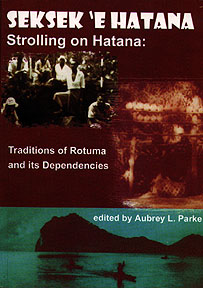|
Seksek 'e Hatana: Strolling on Hatana Traditions of Rotuma and its Dependencies with excerpts from an archaeologist's field notebook With contributions from: 'Aisea Nakaora the elder, Aisea Paka Mös, Atalifo, Elizabeth Inia, Epeli, 'Erinio, Gagaj Fakraufon, Fereti, Fonman, Gagaj Hanfakag, Hanfakag Apao, Sergeant Ieli Irava, Rev Jimi, Katafono, Gagaj Kausiriaf, Kia'a, Kijiana, Leue, Mama'o K., Marasia, Mara'ua, 'Ofa Pene, Riamkau, Riogi, Sakaio, Sakeo, Samuela, Savirio, Sokra'a, Samuela, Soani, Sukamanu, Susau, Tanu, Tavo, Tirotuma, Tirotume Sanimeli, Toaniu, Toniu's mother Tivao, Gagaj Tokaniua, Gagaj Tua', Vafo'ou, Vasea, Gagaj Vuan, Wilson Inia Edited by Aubrey L. Parke
|
||||
Seksek 'e Hatana, is a collection of hanuju, fäeag tupu'a, and rogrogo (myths, legends and stories) as well se some fakpeje (ceremonial speeches) and sua (songs) gathered in 1964 in Rotuma. Many of the tales refer to specific places in Rotuma and its offshore islets. The islet of Hatana is central to the origin myths of Rotuma. Seksek 'e Hatana is more than a record of traditions and memoirs because it includes excerpts from an archaeologist's field notebook. This approach sets the traditions of Rotuma in an archaeological and geographical landscape, and in a context of ceremonial and tradtional activities, signs, and omens. Supernatural and semi-supernatural landscapes and associated archaeological and ethnographic information are in this book based on knowledge and explanations from Rotumans. This book records a large body of information, narratives, memoirs, and observations for future generations. Its text describes sites, linking them with the narratives. Such records provide invaluable information about the past as the people involved saw it. In turn, this information helps us to understand the present and to plan for the future.
|
